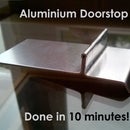Introduction: Add Lights to Your Model Railway / Railroad.
A guide to adding lighting to a model railway, or indeed any small project (but I am focusing on modelling for this instructable). Simple and quick, this makes a nice little extra touch to your layout. It's also really cheap (adding one light to one building costs as little as £0.21 ($0.33 as of 12th June 2012), less if you buy the parts in bulk) and long-lasting if you use LEDs (as shown here). With LEDs, it is slightly harder to install than with normal bulbs, but it is cheaper, longer-lasting and safer due to LEDs having no heat build-up. I generally use cylindrical 5mm LEDs in yellow, to simulate gas lighting (the cylindrical LEDs have a nice, even light distribution compared to normal LEDs, which can 'focus' the light).
You will need:
LEDs, (see above for colour) available from here
Resistors, available from here
Soldering materials
A building (kit form is easier to install lights in)
A power source (probably the auxiliary output of your main controller)
Step 1: Wiring.
Solder a resistor to the negative leg of an LED (if you don't know which leg is which, see the picture above). Then add wires to this assembly (make the wires as long as you need them to reach a power supply). It's a good idea to test it at this point, before putting it into the building. This is also a good opportunity to mark the wires so that you know which one goes to which side of the power supply (+ve or -ve). You don't need to do this if you can afford 2 different colours of wire! I have also included some electrical diagrams for those of you who like this sort of thing. See the pictures for more details.
Step 2: Installation.
Bend the LED legs to 90 degrees and glue the LED in place inside the building. Route the wires out through a hole in the base or somewhere where it is not visible. Feed the wires through your baseboard and then to the power supply. Now just connect the correct wires and terminals, switch on and enjoy!
Step 3: Street Lights.
The same method as described above can be used for adding streetlights, as seen in the pictures. My DIY Lamppost uses a 3mm SuperBright LED with the wires disguised as an ornamental fitting. The LED legs are bent to form the shape of the top of the lamppost (see picture). The wires are soldered on to this and form the post part. The resistor is underneath the baseboard to reduce the thickness of the post. The round part just above the LED is made from the bits you find left over in a holepuncher; it just pushes onto the LED before you bend it.
Step 4: Tips, Tricks and Ideas.
Tips: With building interior lights, it is a good idea to make some sort of interior scene, as an empty interior will stand out like a sore thumb. Also, you may need to paint the inside walls to reduce 'light leak' as cardboard buildings are often too thin to stop the light escaping and you will end up with glowing walls.
Power: my layout uses the 12v DC power supply from my controller and all the resistors are 1k ohm versions. The same setup will run from a 16v AC power supply, but the lights are quite flickery with AC. For buildings with more than one light and for different voltage levels, I recommend using this to determine the resistor values: http://led.linear1.org/led.wiz. My lights are powered from terminal strip which is in turn powered by the controller (see pictures). This saves on wire and also allowed me to include a switch to turn the lights on and off when I want to.
I think that's all I can say, so thanks for reading and please feel free to leave any comments and questions.













